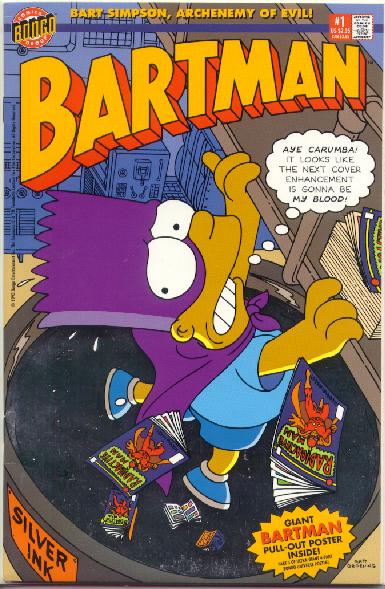Doubles
If you’re here, you are wondering why I have listed more than one of several comics. The answer is very easy. With the exception of Simpsons Comics #31, all the doubles were the four original Bongo Comics. With the exception of two promos, those four comics or eight comics depending upon how you look at it, were the only Bongo comics produced in 1993. As a nice promo, Bongo enclosed a different part of a, "Giant Simpsons Pull-Out Poster," in each of the first four comics. The price for these special comics was a whopping $2.25. Although the price would be raised soon after, that was $0.30 more than the comics that were to follow. For reasons unknown, Bongo also produces duplicates of more expensive comics at regular price. Although it was basically the same comic, there was a catch: there was no poster in the cheaper ones. A few more minor changes also took place on the cover. The four comics with posters are the most propionate and are the comics that are listed everywhere else. I would not consider a collection complete without the cheaper duplicates. The other duplicate listed on this page, Simpsons Comics #31, I would accept an argument for it not being required in a collection. The differences between the two #31 comics are not that big, but I believe that they should be known about. Although, some comics have barcodes and others do not, while some may have different barcodes. I do not know what that pattern is as of yet, and when I do, I will make a page for it. I don't feel a different barcode makes a comic qualify as a necessity to a collection. Below I have listed the differences between each pair of the doubles. If you click on any comic you will see an enlarged version of it. The comic on the left-hand side is "Comic A," and the comic on the right is "Comic B."


- Comic A has a poster, Comic B doesn't.
- Comic A advertises the poster inside, Comic B doesn't.
- Comic A is $2.25, while Comic B is $1.95.
- Comic B has a barcode, Comic A doesn't.


- Comic B has a barcode, Comic A doesn’t.
- Comic B has an advertisement, Comic A doesn't.
- The signatures of the authors are on opposite sides of each other.
- Comic A's copyright info is printed very close to the spine, while Comic B's copyright info is printed a litte away from the spine.


- Comic A has a poster, Comic B doesn't.
- Comic A advertises the poster inside, Comic B doesn't.
- Comic A has a glow-in-the-dark cover, Comic B doesn't.
- Comic B has a barcode, Comic A doesn't.
- Comic A has a fake date, Comic B doesn't.
- Comic A is $2.25, while Comic B is $1.95.
- Matt Groening signatures are switched around.
- Comic B is approved by the Comic Code Authority and has its seal of approval, while Comic A isn't approved and doesn't have their seal of approval.


- Comic A has a poster, Comic B doesn't.
- Comic A advertises the poster inside, Comic B doesn't.
- Comic A has a Silver Foil cover, Comic B doesn't.
- Comic A is $2.25, while Comic B is $1.95.
- Comic B has a barcode, Comic A doesn't.


- Comic A has a poster, Comic B doesn't.
- Comic A advertises the poster inside, Comic B doesn't.
- Comic A is $2.25, while Comic B is $1.95.
- Comic B's barcode forces the sub-title, "'Around the World in 80 Pieces,'" and it's boarder to be compressed, while Comic A doesn't have a barcode.
- The signature of Matt Groening on Comic A is on the left hand side, while Matt Gronening's signature on Comic B is in the middle.
Home |
Quick List |
Picture List |
Doubles |
Posters |
Cards
|









